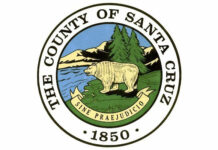By Katie Evans & Christina Wise
The San Lorenzo Valley Water District (SLVWD) and Scotts Valley Water District (SVWD) have considered beginning studies on the impact of a potential consolidation of the two districts.
Both boards hosted Joe Serrano, the Local Agency Formation Commission (LAFCO) Executive Officer, who presented a roadmap for the potential consolidation process. SLVWD hosted an impassioned—and at times vitriolic—meeting about the merger on Feb. 4. SVWD hosted its own meeting a week later and took its first steps toward considering the merger.
Ultimately, the latter passed a conditional motion that staff should begin analysis of consolidation if, and only if, SLVWD also directs staff to explore the possibility. After an inconclusive meeting on Feb. 4, that board will return to the subject in its meeting on March 4.
IN THE MOUNTAINS
For the past five years, the agencies’ general managers, Piret Harmon (SVWD) and Rick Rogers (SLVWD), had regular monthly meetings. They’d discuss the direction of their districts, and share best practices. Rogers says the inter-district collegiality was a refreshing new approach considering the previous rivalry, and it’s been a benefit to each district.
“Scotts Valley was the lead agency on the Regional Intertie Project back in 2013 that resulted in a $3.917 million grant benefitting five different local water agencies, including SLV.” Rogers said. “Currently, we’re working on the joint Urban Water Management Plan document, and we’re seeing that there are significant savings by combining the districts and using one consultant.”
When the topic of merging the two districts came up, both Harmon and Rogers agreed to take the idea to their boards. Both boards agreed to add the idea to their respective meeting agendas, and that’s when things started rocking.
“Neither of us wanted to appear as the aggressor in this situation, so we tried to roll it out at the same time,” Rogers said. “We had talked about this before the CZU August Lightning Complex fire began, so the idea had been on hold since early August. I know people were questioning the timing of introducing the merger, but we’d been sitting on it for six months.”
As for the overall reaction from SLV residents at the Feb. 4 board meeting, Rogers says he wasn’t surprised.
“People are passionate about this topic, but you won’t see residents with balloons standing at the light in Felton in favor of it,” he said. “All of us drive through Scotts Valley, and you look at their growth and wonder if they have enough water. In reality, Scotts Valley’s demand has remained the same—their pumping has decreased by 40 percent from their historical highs in the ‘90s.”
Rogers says that he, Harmon, and several key members of Harmon’s staff are knocking on retirement’s door. By looking at consolidating the districts, Rogers sees the financial benefit of slimming down operations.
“Think about the savings of running one administrative building, only having one manager/director, and reducing overhead costs,” he said.
For now, the two districts are flowing down the same stream in unison. They both draw from the same aquifers and they’re working hand-in-hand on restoring them under the Santa Margarita Groundwater Agency to reach sustainability by 2042.
“Usually, when a merger happens, it’s because one agency needs something from the other. In this case, I think we need each other,” Rogers said. “We’re both small districts, and in order to keep rates low, invest in capital improvements and comply with state regulations, we need a solid customer base to increase revenue. Our district is struggling with increased operational costs, and there aren’t a lot of areas to reduce expenditures. We need to explore the benefits of consolidation—that includes doing some studies and answering folks’ top questions—but I see this as a move that will strengthen both of our districts.”
While residents are concerned about the impacts of a merger, Rogers is worried about what happens if the consolidation doesn’t happen and another, larger agency such as Santa Cruz of San Jose merges with Scotts Valley.
“We already have over 1,000 water connections in Scotts Valley; ultimately, combining the two districts strengthens our position with groundwater and surface water. It gives us greater control, and I think it’s a good fit,” he said. “We’ll need surveys done, and we’ll need data reports from our engineers, and that information will help answer a lot of the residents’ questions. The best way to control our water supply is to have local management of it, so I see a lot of positives.”
At the March 4 meeting, the board will have a conversation about getting basic preliminary information regarding the merger. Rogers hopes that will help the SLV board determine if they want to pursue the idea.
“No decisions have been made, no actions have been taken,” he said. “It’s strictly exploratory; we’re looking at a minimum of two years of board meetings to get information to our ratepayers, and it’s up to both boards as to whether they want to move forward with that exploration.”
DOWN THE VALLEY
Harmon echoed Rogers at the SVWD Feb. 11 meeting, saying that the meeting was “this is the first step of the first step, just to see if the board is interested in giving staff direction.”
“Let’s see if there is merit to this proposal. I’m not convinced there is,” she said. “We may come out of this study and find that there are as many downsides as merits. But I am a person of facts and I need to look at something tangible and quantifiable to bring a recommendation to the board.”
During public comment participants voiced concerns over the cost of conducting analysis, differing consumption rates between the two valleys and employee representation. Harmon struggled to see a disadvantage in considering consolidation.
“I’m too much of an engineer for that, everything should be evaluated for efficiency, unless it’s too expensive or our partner is unwilling from the get-go,” she said.
According to Serrano, if both boards direct staff to begin analysis, LAFCO would fund one-third of the fee for an outside consultant hired to conduct a detailed analysis.
The trouble, Director Chris Perri said, is both agencies—staff and ratepayers—need to be willing to merge.
“If they’re not taking an action, I don’t want it to appear as though we are the ones driving this,” he said.
Director Wade Leishman echoed Perri: “It feels like we’re both strapped up to bungee cords at the end of the bridge, holding hands, saying, ‘You jump first,’ ‘No you.’
“The first person might jump and the second person could stand there and change his mind… If we jump first, then we are the aggressor. We are trying to take over, that’s the message,” he said. “Until we’re really sure they’re a willing participant… I worry about jumping off the bridge first. I’d like to be hand-in-hand.”
Harmon originally proposed consolidation to Rogers because of the potential increases in efficiency of both districts. According to Harmon, consolidation could allow for the elimination of many redundancies such as top executive positions, support services (legal counsels, auditors, public outreach, web hosting) and professional services (integrated regional water management agencies, LAFCO, engineering consulting, hydrogeological consulting). Consolidation could also reduce time spent on regulatory reports, lead to better utilization of assets, and larger departments would provide better customer service coverage, Harmon says.
“All of this is expected to result in increased efficiency, reduced operating expenses, lower rate increases, improved customer service, increased job satisfaction, and productivity,” she said.
Consolidation might also improve the work environment, she says.
Despite the potential positives, some SVWD staff expressed concerns during the board meeting, calling into question the timing of the move. Harmon said change is always difficult, and even more so when so little information is available.
“I’m very proud of them, that they came forward with their fears,” she said. “I heard from them some great ideas. I want to make sure, if it were to go forward, that they can be part of designing the new organization.”
For now, the districts await the March 4 meeting.
“Based on what they heard from us, I hope that the [SLVWD Board] will decide to act,” Harmon said. “For now, it’s a waiting game.”
Get in touch with the Scotts Valley Board of Directors at https://www.svwd.org/board. Read up on the Feb. 11 meeting at https://www.svwd.org/board-meetings.













Oops! This image is for Loch Lomond in Scotland.